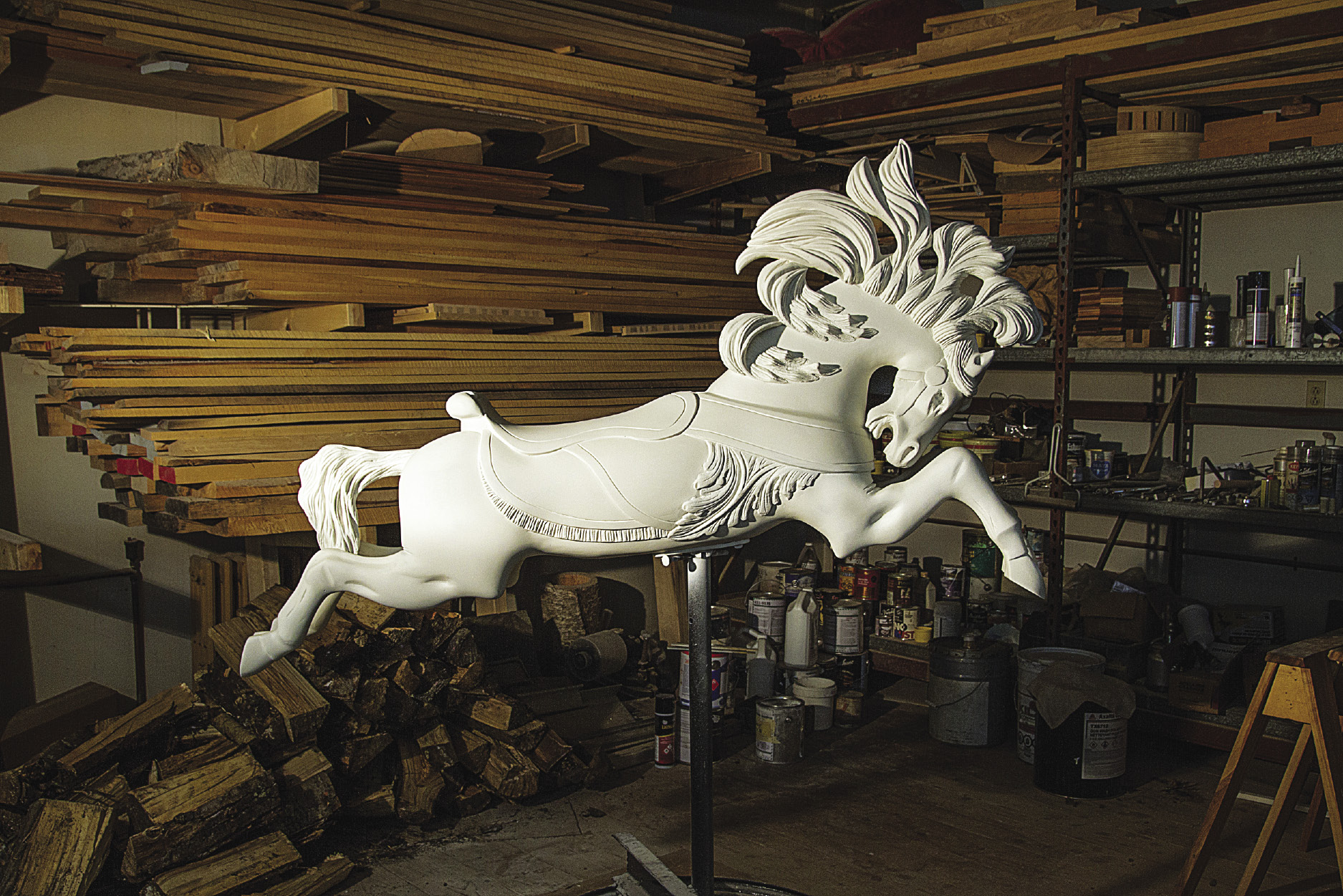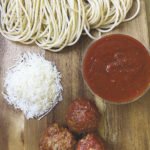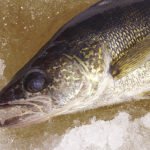Generations of children have ridden the wooden carousel horses at Thunder Bay’s Chippewa Park. For many, the memory of riding on a carousel lingers for life. Now, after a century of service, the carved wooden horses of the C.W. Parker carousel have become tired and in need of repair. Local woodcrafter and sculptor Vic Germaniuk was contracted by the City of Thunder Bay to begin the wooden horse restoration project, which is part of a larger effort to restore the carousel to its original factory condition.
The restoration project was initiated by The Friends of Chippewa Park with the support of the City of Thunder Bay, Parks and Open Spaces Division. Funding for the project comes from multiple sources, with contributions of $200,000 from the city, $100,000 from Canada 150 and a fund-raising effort with a goal of $900,000, of which $386,000 has been raised as of this writing. A direct-ask, “Adopt a Horse” campaign is just getting started.
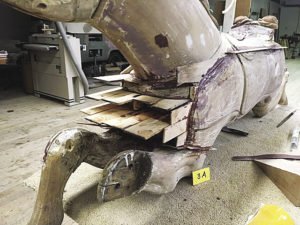
Eleven horses from the outer or A ring of the carousel are currently stabled at Germaniuk’s shop, Woodcraft Design, in Kaministiqua. They arrived there stripped of paint and coming apart at the seams, because the carved wooden pieces from which they are constructed have begun to delaminate due to the slow deterioration of the original hide glue. Germaniuk says this is to be expected on a carousel constructed 100 years ago. Actually, the wooden horses are in surprisingly good condition.
“For almost 50 years, the carousel was stripped down and stored indoors during the winter,” Germaniuk says. “The city did a good job of looking after the horses.”
That said, park workers did what they could to keep the horses from falling apart over the years by adding nails and screws to thwart the delamination and rot. The first task for Gemaniuk and his crew was removing the nails and screws that were not original; sometimes dozens per horse. Then they used epoxy and wood shims to hold the pieces together and fill the gaps caused by delamination and deterioration. They’ve also replaced wood that has rotted away. Then the horses are sanded down to restore their original form.
Germaniuk is well-suited to the painstaking task of restoration. After owning a sign-painting business in Thunder Bay, he began doing woodworking projects in homes and businesses. One of his projects was the interior work at the Thunder Bay Museum. An artist and sculptor, he also has done snow-carvings with his friend Michael O’Connor at Marina Park in Thunder Bay and all over Minnesota. O’Connor is assisting with painting the horses, along with Michelle Rienelt. Woodworkers involved in the project are Sandra Bertin Ross, Jaret Wing, Holger Remmer and Tom Ihala.
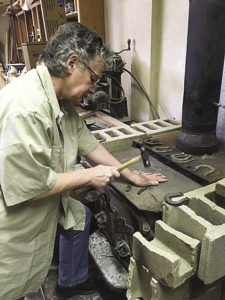
The carousel arrived at Chippewa Park in 1935, replacing an old and dilapidated merry-go-round. The Parker traveling carousel was purchased from Mrs. Maude King of “King’s Royale Canadian Shows” for $1,750, payable in three yearly installments. While the Parker company made many carousels, there were only three in this particular series. It was outfitted with an Eli engine and a Wurlitzer organ.
The horses were hand-carved with elaborate detail from flowing manes to tiny puppies adorning the edges of the saddles. On some horses, portions of the carvings were damaged or missing. Germaniuk has carved new manes, trying to replicate the original work. Doing so wasn’t easy. He tried using the mane from another horse as a pattern, but found it was similar, but not the same as the horse he was restoring. With further research, he discovered Parker carvings were not exactly the same.
Work on the project has been guided by the Heritage Standards and Records subcommittee of the Carousel Restoration Committee, which hired a consultant who is an expert in carousel restoration, Lisa Parr, of Old Parr’s, Inc. of Highland, Illinois. Germaniuk has only met with her once, when she came to Thunder Bay to view the progress on the project.
“She seemed happy with the work,” he said, “and had some suggestions for us.”
One of those suggestions was somewhat surprising. Germaniuk says he is very meticulous in his work. Parr asked him not to remove all of the little imperfections, such as filling in tiny pockmarks in the wood, because doing so will make the finished horse appear as though it was constructed of a synthetic material, rather than being carved from wood.
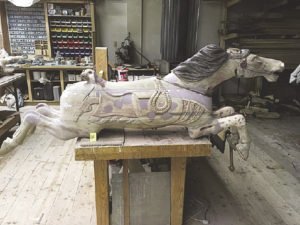
Parr has provided the painting patterns for the horses, which are being painted with One-Shot sign painters’ enamel. Germaniuk was instructed by the city not to display images of the painted horses until after they are unveiled by the city at the park in late May. Suffice to say the finished horses are boldly colorful.
The full carousel will be up and running for the summer season, the first weekend June through Labour Day. In addition to Germaniuk’s restored horses, the center column panels will be stripped, repaired and repainted.
After the season ends in September, the remaining horses will be restored. The rounding boards will be fully restored and painted with iconic local scenes. One of the chariots (benches) will be restores and the other will either be replaced with a wheelchair tie-down or modified to allow a wheelchair to be placed there. All of the wood beams will be sanded, repaired and repainted; the brass poles cleaned and polished. The entire electrical system will be replaced and the mechanical system either repaired or replaced. The carousel will get a new canvas roof and the exterior fence will be replaced with one more historically accurate. Then the horses will be truly ready for another century of service to the children of Thunder Bay.


